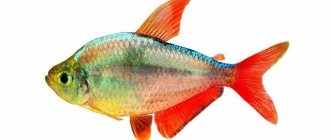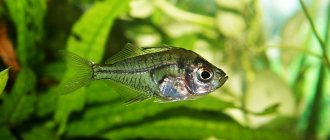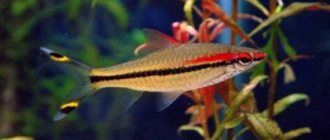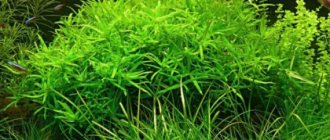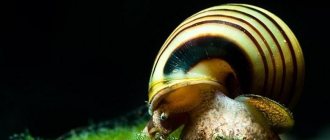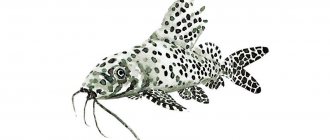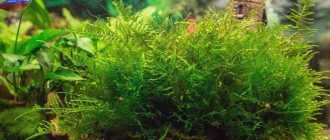Why are dwarf cichlids so attractive?
It is incorrect to call the Bolivian butterfly a Bolivian apistogramma; more correctly, it is a dwarf cichlid (it grows no more than 9 cm in length), chromis butterfly, microgeophagus or papilochromis. The Bolivian butterfly is popular all over the world thanks to:
- exoticism and South American origin;
- non-capricious character and good compatibility with other fish;
- pickiness in food;
- simple maintenance in an aquarium (even beginners can cope);
- inexpensive;
- attractiveness.
In addition, she is very smart: she can recognize the owner and, when he approaches the aquarium, beg for food.
Habitat
From the name of the fish it is obvious where it comes from. But Bolivia is only the place where the first chromis was caught (in 1911); in fact, the fish lives in many reservoirs of the South American continent, most often found in Bolivian and Brazilian waters: Mamora, at the mouth of the Rio Guapore (Bolivia) and Igarape Miri (Brazil) ), migrates through the floods of Todos Santos.
Microgeophaguses love weak currents or standing water, since in these places there is always enough vegetation, snags and branches where they can hide from predators. Mainly prefers the bottom and middle layers, where you can rummage in the soil, look for tasty insects and larvae. But it doesn’t swim to great depths; it prefers shallow water warmed by the sun (sandy or muddy – it doesn’t matter).
On the surface, it also hunts for the fry of other fish, but appears there rarely, so as not to end up in someone’s stomach. As already mentioned, the Bolivian butterfly is a very smart fish. Cichlids are not specifically classified as gregarious or solitary, since they can be found in schools, in pairs, and alone.
Nutrition
In nature, they feed by sifting sand with their mouths in search of various organisms. In a home aquarium, sand is also key to the feeding process. Feed drowning dry food with plant additives, such as flakes, granules. If possible, serve frozen brine shrimp, daphnia, and bloodworm pieces. The food particles should not be large; the fish is not able to bite off, but swallows it whole.
Our product Aqvium natural dry food for small and medium fish from clean lakes of Siberia and Northern Crimea in environmentally friendly biodegradable packaging.
Find out more
Appearance
The miniature chromis was called a butterfly due to its large transparent fins . It is not difficult to recognize the species by its oval (ovoid) elongated body , strongly compressed sides and pointed fins. Males have longer and sharper fins, and they themselves are larger (8-9 cm) and brighter. Females grow up to 6-7 cm. In the natural environment, the sizes differ, the fish can be larger.
The fish are classified as South American freshwater cichlids due to their characteristic body shape and body structure. The body is yellowish, only the head and chest are orange. The entire body is decorated lengthwise with wide light gray vertical stripes, which are almost invisible in the dark, but they are noticeable under the bright rays of the sun. The eyes are blue-black, and there is a black stripe above them.
The fins are also interesting: the dorsal one is the largest, highest, starts from the back of the head and goes to the base of the tail. A red stripe is drawn along the very top of the fin and a similar one is found on the edges of the caudal fin. On the chest there is a pointed fin with a more complex color, which constantly changes depending on the light - from heavenly to orange. The anal fin has an orange or pink tint. Thus, the fish can boast of almost all the colors of the rainbow in their color.
Varieties of apistogram
In addition to the traditional form (apistogramma - butterfly), there are several breeding varieties. It was possible to obtain them only in recent years; before that, such fish simply did not exist. Types of apistograms also differ in color, body shape and fins. The most common variations include the following:
- Apistogramma ramiresi balloon - differs from the natural appearance by a shortened and vertically elongated body. Most of all, this body shape resembles a tiny discus. The round fish has less vitality and is more demanding in terms of keeping conditions than the natural Apistogramma butterfly, so only experienced breeders can keep balloons.
- Electric blue is the name of one of the fashionable colors. The apistogramma balloon, a fish with a normal body, and veil forms can have this color. The peculiarity of the color lies in the highly developed sparkles, which leave no room for shades of “wild” colors. Only on the forehead, where there are no sparkles, can you notice a yellow spot. The rest of the scales and fins of the fish flicker with many blue sparks, reminiscent of electrical discharges.
- Color forms also include varieties with gold and red-gold colors.
- There are also albino forms with white scales and a subtle cream pattern of stripes on the back.
- Apistogramma ramirezi veil has overly developed, elongated fins that sway beautifully when moving. The veil “plumage” makes the fish inactive, but it looks simply charming. Fish with such fins can be golden, red or white, or electric blue in color. Both butterflies and ordinary butterflies can have veil fins.
The combination of characters in different variations allows us to divide apistograms into species more numerous than those given in this list. Relatively recently, the golden electric form has appeared, combining the characteristics of blue and golden fish. There is also an electric blue orange variety with a bright orange spot on the head. Breeders are constantly working on developing new forms, but the peculiarities of such fish - the high price and demanding conditions of keeping - make them unsuitable for beginning aquarists.
Conditions in the aquarium
Bolivian butterflies like communal aquariums, but the capacity must be at least 60 liters (in a smaller volume the fish will not be able to reproduce). Cichlids are unpretentious and do not require special care; a basic aquarium kit is sufficient:
- the water can be with a weak current or stagnant, well filtered (change at least 20% of the water every week);
- pH – stable within 6.0-7.8;
- hardness – 6-18 dGH;
- temperature – from +22 to +27°С;
- a little ammonia and more oxygen in the water will provide the fish with maximum color;
- Fine sand is ideal for the soil, in which fish like to rummage;
- the main thing is to take care of shelters, since the fish are timid (branches, snags, ferns, snags, pots or cups with holes, etc.).
Bolivian butterflies eat any food - artificial and live (frozen bloodworms, coretra, tubifex). In their natural environment, they feast on insects, detritus, fry and caviar.
Ideally feed 2-3 times a day, but in small portions.
Chromis are not greedy, they eat slowly, and if they overfeed, the remaining food will go to waste at the bottom.
They love light, but not direct, but diffused - this can be achieved by vegetation floating on the surface of the aquarium. Butterflies do not spoil vegetation and are as friendly as possible with other inhabitants.
The Bolivian butterfly is a very independent and freedom-loving fish - males carefully select females for spawning. Taking this into account, to obtain offspring you will need to keep at least 6 fish of different sexes. And this will require an aquarium of at least 80 liters. If, in addition to microgeophagus, it is planned to contain other aquatic inhabitants, then the container should be even larger.
In an artificial tank, Bolivian cichlids live for 4 years, but 7-year long-livers have also been recorded.
Notes
- Reshetnikov Yu. S., Kotlyar A. N., Rass T. S., Shatunovsky M. I.
Five-language dictionary of animal names. Fish. Latin, Russian, English, German, French. / under the general editorship of academician. V. E. Sokolova. - M.: Rus. lang., 1989. - P. 302. - 12,500 copies. — ISBN 5-200-00237-0. - Myers GS, Harry RR (1948) The Ramirezi dwarf cichlid identified. Aquarium, Philad. 77.
- Leibel WS (1993) A fishkeepers guide to South American Cichlids.
Tetra Press. Belgium. 55-56. - Robins CR, Bailey RM (1982) The Status of the Generic Names Microgeophagus
,
Pseudoapistogramma
,
Pseudogeophagus
and
Papiliochromis
(Pisces: Cichlidae)
Copeia 1:
208–210.
Compatibility with tankmates
Do not forget that the chromis butterfly is still a cichlid, even if it is the calmest of all. A predator is a predator. In relation to other inhabitants of the aquarium, microgeophagus are non-aggressive; they are more likely to scare than harm, as they conquer the territory. But the fry and eggs of those fish that are planned to be bred in the same container will be eaten.
The instincts of dwarf cichlids are stronger than their peaceful nature, so it is better to house them with fish of equal size. For example, they get along well with barbs, gourami and corydoras.
The presence of several male chromis in the aquarium will require more shelters and a larger container - they will regularly fight among themselves. If you do not plan to breed them, then it is better to buy a pair or one individual. After pairing, it is better to remove the remaining cichlids.
Peculiarities of reproduction of chromis butterflies
Females and males of Bolivian butterflies can only be distinguished in a state of full maturity. Males are distinguished by their bright colors and pointed fins, and in addition, they are larger and more graceful than females. Under natural conditions, dwarf cichlids easily find a partner and form a strong, indestructible pair. If another male claims a busy female, he will not be happy.
One pair can lay about 200 eggs. In artificial conditions, it is difficult for fish to choose a partner, since they are quite picky in this regard.
If you want to engage in full-fledged breeding of Bolivian butterflies (to sell them in the future and make money from it, for example), you will have to buy a 100-liter aquarium with 10 individuals.
After everyone has split into pairs, those left without a pair are given to other aquarists or sold, since single fish will not survive among established pairs. To prevent the offspring of chromis butterflies from being eaten by neighbors in the aquarium or other cichlids, you need to place the parents in a special spawning tank. The spawning area should contain smooth stones or broad-leaved plants on which the females will lay eggs. Maintain the water temperature within +26-28°C, maintaining diffused dim light.
The owner will not miss the spawning time, this is noticeable in the actions of the fish: a couple almost constantly cleans the place chosen for spawning - such preparation is difficult not to notice. The spawning process will be interesting for beginner aquarists: the mother chromis swims several times to the surface of the water, lays eggs, which the father chromis located below manages to fertilize.
From 100 to 200 eggs is a feat for both. The male also participates in the future life of his offspring: while the female fans the eggs with her fins, the male stands guard and protects the clutch, and then helps the “wife” with the rest. After almost 3 days, the eggs hatch and are transferred by the parents to a safe place chosen in advance. The larvae will turn into fry within a week, sometimes a little earlier you can watch them swim. And again the female and the male move them - hiding will take place several more times a month until the babies grow up and get stronger.
The fry need clean water and are very sensitive to the environment. You need to feed it several times a day in small portions, and remove the leftovers. It is better to start with food that the fry can eat - this could be egg yolk or microscopic worms. Grown-up Bolivian cichlids are transferred to standard food.
Care
Mandatory butterfly care includes:
Combine soil cleansing with weekly water changes. Test your ammonia levels with water tests once a week.
Feeding
Butterflies tend to overeat, so feed the fish as much food as they eat in 5 minutes. After feeding, remove uneaten food particles. The omnivorous nature of fish allows them to have a varied diet.
Suitable frozen and live foods:
Diversify your diet with plant foods:
Use dry food as a supplement to your diet.
Diseases
Unfortunately, Bolivian butterflies are considered the most painful and sensitive to any changes in conditions. Interestingly, the fish can even tolerate temperature fluctuations and tolerate changes in parameters. But at a reduced temperature, the fish develop weakness, forcing them to rise to the surface. This can be recognized by frequent opening of the mouth and swelling under the gills. The temperature should be adjusted immediately.
You cannot completely change the water in the aquarium, as the content of sodium salts, ammonia and chlorine will increase, which will cause a rapidly growing brain tumor in the fish. If black spots and gray nodules begin to appear on the body, this is one of the incurable diseases. The eyes bulge due to tuberculosis or dropsy. When transplanting to another aquarium, you should also be more careful; some individuals die, unable to adapt to the new conditions.
The standard treatment is to raise the water temperature, this usually helps, unless the cause is parasites or tumors. It is better to try to recreate an environment as close as possible to the natural one, then the Bolivian butterfly will feel great and the owner will be happy every day.
According to aquarists who have been keeping and breeding chromis butterflies for a long time, watching these beautiful fish is a great pleasure, and you don’t need to spend a lot of effort on care and maintenance.
You can even communicate with these fish; they love their owner and willingly swim when they first appear near the aquarium.
Bolivian butterflies do not require special maintenance; all novice aquarists can easily handle them, following a short list of rules. Some people even manage to keep chromis in a small aquarium: not for the sake of offspring, but for the pleasure of watching the miniature South American.
Spreading
The Ramiresi apistogram is native to South America. Under natural conditions, it can be observed in the rivers of Colombia, Venezuela and Bolivia. “Butterflies” settle mainly in small springs, where the water warms up to 30C, there is no strong current, and the bottom is covered with dense thickets of aquatic plants.
In 1947, in one of these streams, a famous researcher and one of the largest suppliers of aquarium animals, Manuel Vincent Ramirez, saw and caught a bright fish. Despite the fact that this was not his first and not his last discovery, it was to the colored beauty that he wanted to give his name
There is a legend among aquarists that Soviet animators, when creating the image of the Goldfish for the film adaptation of Pushkin’s fairy tale, were inspired by the beauty of the Ramiresi apistogram.
